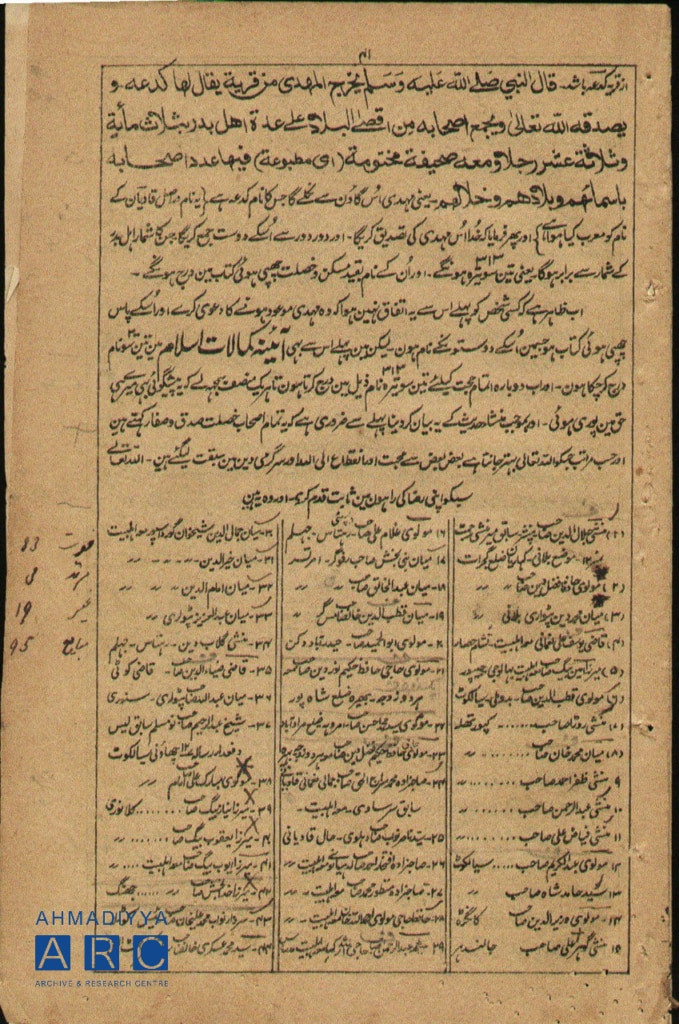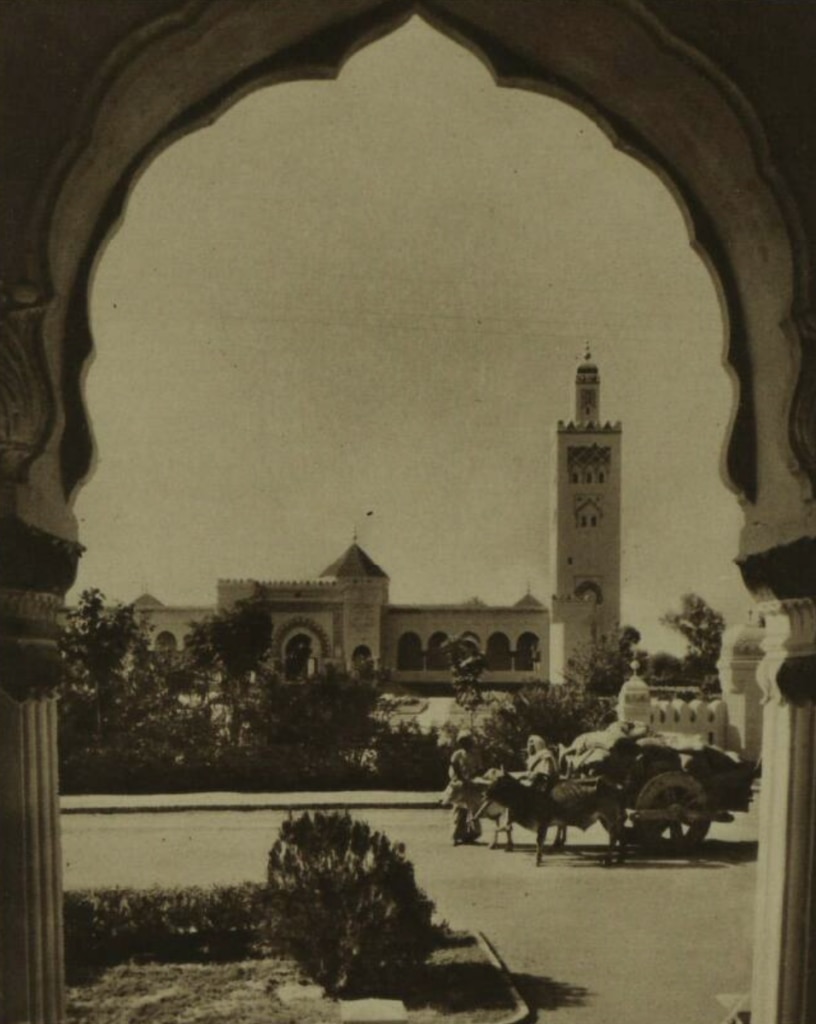Sami Fakhra Jadran-Ireland, Maryland USA
When my beloved mother, Syeda Bilquis Sadaqat Sami Jadran, wife of the late Mohammad Abdul Sami Jadran of Virginia, passed away in September 2024, I learned that her great-grandfather was a companion of the Promised Messiahas.

I wanted to learn more about this devoted companion, who is listed as number 10 on the 313 companions’ list given by the Promised Messiahas himself. (Zamima Anjam-e-Atham, Ruhani Khazain, Vol. 11, p. 325). So my search began.
In my quest, I discovered a story about a humble companion of Promised Messiahas who had read the book Barahin-e-Ahmadiyya and later used it to preach to his friend. He took the Bai‘at (pledge of allegiance) and later on moved to Qadian. Through Allah’s guidance, he was brought into the fold of the Ahmadiyya Jamaat. This account is sentimental to me as it relates to my beloved mother’s great-grandfather. I wish I had known and read about him while my mother was alive. I wonder what other details she could have provided. May Allah grant them all Jannat-ul-Firdous.
First, I’m sharing some of what I found in Al Fazl Rabwah:
“The Promised Messiahas published four parts of Barahin-e-Ahmadiyya from 1880 to 1884. This period was a tumultuous time for religion. Attacks were being made from all sides against religion and the esteemed person of the Holy Prophet, peace and blessings be upon him, particularly by Christians and Aryas, who were at the forefront of such assaults.
“In defense of religion and to articulate the truth of the Holy Prophet, peace and blessings be upon him, the Promised Messiahas provided such conclusive arguments and proofs in this book, Barahin-e-Ahmadiyya, that it was impossible for any opponent to refute them. This book was published throughout India, and the Promised Messiahas himself sent copies of it via post to distant and nearby regions. Where this book struck like lightning upon the enemies of religion, it appeared as a heavenly glad tidings for the lovers of Muhammad, the Chosen One, peace and blessings be upon him, and the followers of the true religion. Anyone who read this book with a sincere and pure intention found the beauty of the true religion and the status of the Quran manifest, and they became enamored with its author, Hazrat Mirza Ghulam Ahmad Sahibas Qadiani.
“Among those who were influenced was a venerable elder, Hazrat Munshi Abdur Rahman of Kapurthala. He was a resident of the town of Sarawah in the Meerut district of Uttar Pradesh and had moved to the state of Kapurthala with his father at a young age, where he took up employment. Upon studying Barahin-e-Ahmadiyya, he became a believer in the Promised Messiahas, and when the announcement for taking the oath of allegiance was published, he immediately set out for Ludhiana to take the oath after performing Istikhara [prayer for guidance] and became a part of the first Bai‘at [oath of allegiance].” (Al Fazl, 6 October 2001, p. 3)
Here is what I found in a book printed in Urdu, titled Teen Sau Teerah Ashab-e-Sidq-o-Wafa, by Nasrullah Khan Nasir and Asim Jamali:
“10. Hazrat Munshi Abdur Rahman Sahib […] Kapurthala
“Birth: 1839 AD. Initiation: 23 March 1889. Death: 26 January 1937.

“Introduction: Hazrat Munshi Abdur Rahman, may Allah be pleased with him, was a resident of the town of Sarawah, District Meerut. His father’s name was Sheikh Habib Ali Sahib, who was a police officer in District Bulandshahr. He was born in 1839. At a young age, he moved with his father to the State of Kapurthala and took up employment in the Land Settlement Department. He belonged to the ahl-e-Hadith sect.
“Initiation and its Background: Upon studying Barahin-e-Ahmadiyya, he became a believer in the Promised Messiahas, and when the announcement for initiation was made, he immediately proceeded to Ludhiana after performing Istikhara [a prayer for guidance] to take the oath of allegiance, and he became part of the first initiation on 23 March 1889, in Ludhiana. According to the Bai‘at initiation register, his initiation number is 59, with the address listed as Sarawah, Tehsil Hapur, District Meerut. At that time, he was in Kapurthala. Regarding the initiation, he stated:
“‘An advertisement for Bai’at was published from the place of Ludhiana. It stated that anyone who wishes to take Bai‘at should do so after performing the prayer of Istikhara, as long as they are aware of it; if they know they should come, then they should come, and if they know they should not come, then they should not come. I, the humble one, performed the Sunnah prayer of Istikhara that night and prayed, then went to sleep. In my dream, I heard a voice saying, “Abdur Rahman, come.” I set out for Ludhiana early in the morning.’
“Departure for Qadian: He received a pension in 1919 and took residence in Qadian. During this period, Hazrat Munshi Fayyaz Ali Kapurthala retired from the department of engineering and went to Meerut district. Both had studied together in childhood. There was no familial relationship, but due to living in the same place, they were friendly. Hazrat Munshi Abdur Rahmanra had called him from Sarawah and arranged for his employment. He gave half of his house to Hazrat Munshi Fayyaz Alira, and through him, he was blessed with the opportunity for Bai‘at. As far as religious friendship is concerned, in 1919, when Hazrat Munshi Sahibra retired and came to Qadian, both of their desires to live together became a divine arrangement. Both participated in the system of Wasiyyat. Hazrat Munshi Fayyaz Alira passed away in Delhi and was buried in the Bahishti Maqbarah. Hazrat Munshi Abdur Rahmanra also passed away on 26 January, 1937, in Qadian and was buried in the Bahishti Maqbarah. Thus, both friends, residents of Sarawah, worked together in one place. They took Bai‘at at the same time and, according to the Wasiyat, were buried in the same place in the Bahishti Maqbarah.
“Mention in the writings of the Promised Messiahas: The Promised Messiah Maudas has mentioned in Izala-e-Auham, Asmani Faisla, Aina-e-Kamalat-e-Islam, Tohfa-e-Qaisara, Siraj-e-Munir, and Kitab-ul-Bariyyah, as well as in his Malfuzat, regarding his special beloved ones who attended the annual gathering, the donors, and the peaceful community members.
“Death of Hazrat Munshi Abdur Rahmanra: He passed away on 26 January 1937, at the age of nearly 100 years and was buried in the Bahishti Maqbarah in Qadian.” (Teen Sau Teerh Ashab-e-Sidq-o-Wafa, pp. 36-37)
Although it is not mentioned in this book, he was also the father of Hazrat Amtullah Begum, my late maternal grandfather, Syed Saeed Khalid of Karachi’s mother, and wife of the late Hazrat Syed Abdur Rahim Shahra. Thus, my mother, Syeda Bilquis Sadaqat Sami Jadran’s grandmother, makes Hazrat Munshi Abdur Rahmanra my mother’s great-grandfather.
Requesting Prayer
I had written an article on his progeny through his daughter Hazrat Amtullah Begum’s first son, Syed Saeed Khalid, of Karachi, in Ahmadiyya Gazette USA/Al Nur USA 2025. I kindly request prayers for all of us who now reside mostly in North America.
May our new generation dedicate themselves to spreading the message of Islam Ahmadiyyat, becoming devoted to Salat, reciting the Holy Quran daily, and volunteering for Jamaat-e-Ahmadiyya as our elders did. May Allah protect us and our children and keep us more devoted Ahmadi Muslims than ever, so we can live up to the legacy of our ancestors.

